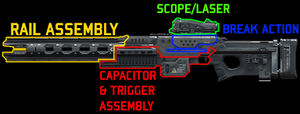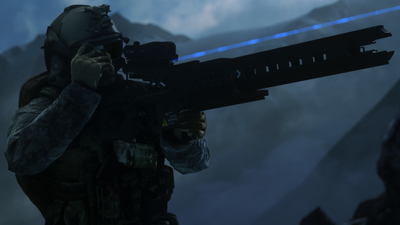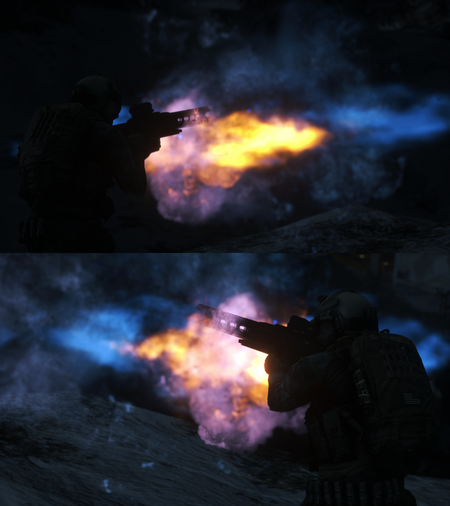No edit summary |
No edit summary |
||
| Line 1: | Line 1: | ||
[[File:Mk1.png|thumb|right|The Mark 1 Special Applications Anti-Armor Weapon.]] | [[File:Mk1.png|thumb|right|The Mark 1 Special Applications Anti-Armor Weapon.]] | ||
The <b>Mark 1 Mod. 0</b> "Railgun", known formally as the '''Mark 1 Special Applications Anti-Armor Weapon''' ('''SAAAW''') is a man-portable, shoulder-fired assault weapon that propels heavy saboted projectiles at hypersonic velocities. | The <b>Mark 1 Mod. 0</b> "Railgun", known formally as the '''Mark 1 Special Applications Anti-Armor Weapon''' ('''SAAAW''') is a prototype man-portable, shoulder-fired assault weapon that propels heavy saboted projectiles at hypersonic velocities. | ||
==Design== | ==Design== | ||
Revision as of 20:07, 26 July 2017

The Mark 1 Mod. 0 "Railgun", known formally as the Mark 1 Special Applications Anti-Armor Weapon (SAAAW) is a prototype man-portable, shoulder-fired assault weapon that propels heavy saboted projectiles at hypersonic velocities.
Design

Measuring in at 1.26 meters in length and weighing nearly 30 pounds, the weapon is far too unwieldy for regular infantry use. As such, it is issued on a team-by-team basis, with one member of the team designated as the operator with two other people designated as ammo bearers and/or assistant gunners. There are two major components of the Mark 1, the weapon, which consists of the capacitor and trigger assembly, break-action, and smart scope, and the rail assembly, which is one large piece that is removable from the weapon.

The capacitor assembly starts at the end of the trigger guard and extends through the fuze box and protrudes slightly underneath the rail assembly. The fuze box, marked clearly by a yellow caution sign, has one switch on it to reset the circuit breakers, as they must be reset after each round. The trigger itself is a two-stage design, and, providing that the capacitors are active, a short pull will feed power to the rails and the targeting laser, allowing for rapid target acquisition, and a full, long pull will fire the weapon. There is a short 1-second charging time for the capacitors once the trigger is depressed, however, which cannot be bypassed with a long pull. Located above the trigger is a manual safety switch, which blocks the trigger and power from the capacitors.
The break-action loading ramp is opened by an ambidextrous switch located underneath it. There is a small, rifled barrel inside, where the round is inserted. The small charge on the end of the saboted slug is fired from the open bolt, which must be manually cycled by means of a charging handle on the right hand side of the weapon.

The scope sits on top of the break-action ramp and is coupled to both a rangefinder and targeting laser, automatically compensating for distance. The laser shines blue by default, although the colors are changeable. The charge progress is displayed in the scope lens.
The rail set is removable from the main weapon, allowing for easier transport as it is over half of the weapon's overall length. To remove it, there is a clamp on the right side of the weapon that can be pulled upwards and around to the top of the weapon, thus unlocking the rails. Removal is as simple as sliding the rail assembly out of the weapon, and putting it back together is the exact opposite procedure.
Ammunition
The ammunition used in the Mk. 1 is a heavy .30 caliber (7.62mm) ring-saboted ferro-nickel alloy slug with a length of roughly 30mm, crimped into a shortened .50 caliber (12.7mm) case with a small amount of propellant. When the weapon is fired, from the open bolt, the small charge propels the projectile into the rails, where it is rapidly accelerated to upwards of Mach 10.5. This design function technically disqualifies the Mk. 1 from being classified as a railgun, although it is still referred to as one for brevity's sake.
Operation
To set it up from the travelling carry position, the operator must first remove both the weapon and the rails from their bags and put them together. Next, the safety selector must be switched off and the fuse box should be switched to the READY position. One round should then be loaded, and the bolt should be pulled back. Before firing, the operator must check their side areas to ensure nobody will be caught by the side blast. Once the sides are secure, the shooter should declare that the side blast area is secure, and then both the gunner and the assistant gunner should announce the firing by both yelling "railgun" in succession. Then, the weapon is clear to fire.